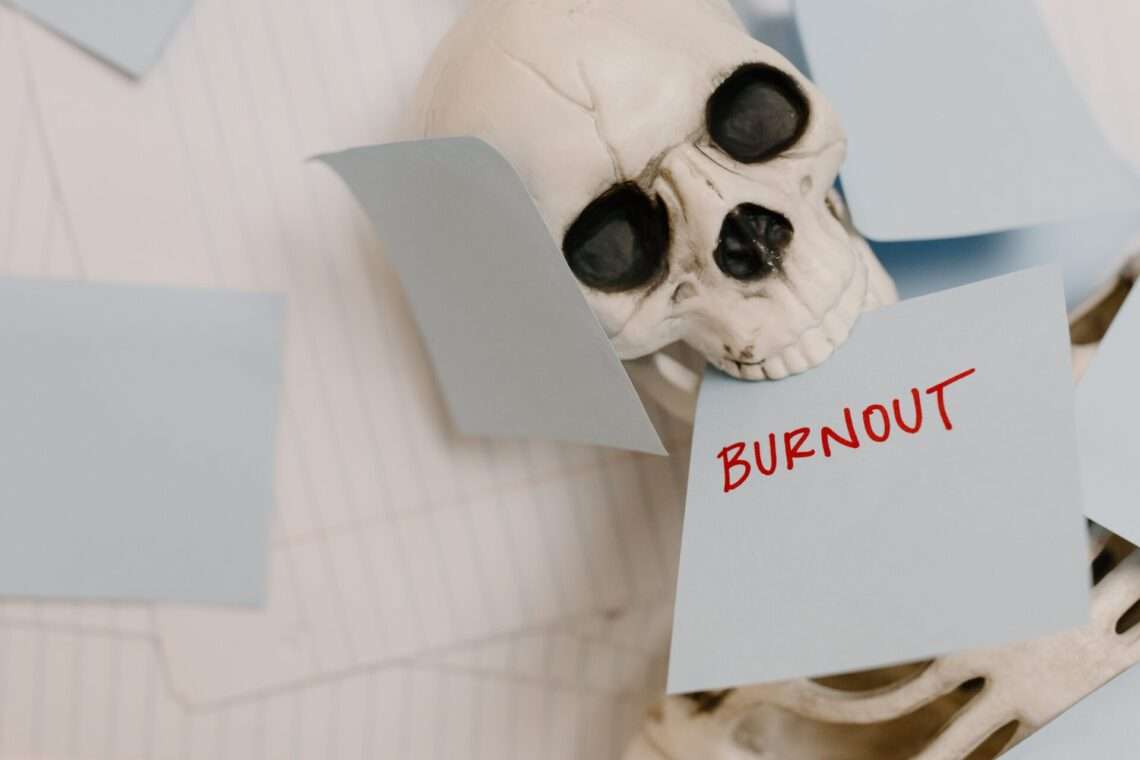
Recognising The Warning Signs: 5 Indicators of Burnout
Burnout is a psychological phenomenon characterised by chronic workplace stress that has not been successfully managed. It often leads to feelings of exhaustion, cynicism, and inefficacy, resulting in reduced professional efficacy. Burnout can affect individuals in various professions and has become a significant concern in today’s fast-paced and demanding work environments. In this blog, we will explore five signs of burnout and delve into the practical reasons behind them.
Burnout: A brief explanation:
Burnout is not just a temporary feeling of being tired or stressed; it is a more profound and persistent condition that can have serious consequences for an individual’s mental, emotional, and physical well-being. It typically arises when the demands placed on a person exceed their ability to cope with those demands. Burnout is often associated with chronic workplace stress, and it can manifest in feelings of fatigue, detachment, and a sense of reduced accomplishment or efficacy.
Prevalence and Impact on Individuals:
The prevalence of burnout is widespread across various industries and professions. It affects individuals in a range of roles, ranging from healthcare and education to business and technology. The fast-paced nature of modern workplaces, coupled with high expectations and constant connectivity, contributes to the increased risk of burnout.
The impact of burnout on individuals is multi-faceted. Physically, it can lead to symptoms such as chronic fatigue, insomnia, and changes in appetite. Mentally and emotionally, burnout may result in feelings of cynicism, detachment from work, and a diminished sense of personal accomplishment. This can further lead to a decline in overall job performance and job satisfaction.
Burnout not only affects the individual but can also have ripple effects on relationships, both personal and professional. It can strain interactions with colleagues, friends, and family, as the person experiencing burnout may struggle to balance work and personal life.
The Relevance of Identifying Early Signs:
Recognising the early signs of burnout is paramount to preventing its escalation and mitigating its adverse effects. Early intervention allows individuals to address the root causes of stress and exhaustion before they reach debilitating levels. Identifying signs such as persistent fatigue, changes in work habits, and increased irritability can empower individuals and organisations to implement strategies for stress management, workload adjustment, and support systems.
Moreover, early detection of burnout promotes a proactive approach to well-being, fostering a culture that prioritises mental health and work-life balance. By addressing burnout at its nascent stage, individuals can regain a sense of control over their professional lives and maintain a healthier equilibrium between work and personal commitments.
There are five key indicators that can help you identify when you might be experiencing burnout:
Sign 1: Persistent Exhaustion
Persistent exhaustion is a hallmark sign of burnout, characterized by an overwhelming and chronic sense of fatigue that extends beyond normal tiredness. It goes beyond the occasional tiredness that comes from a busy day or week and becomes a constant state, affecting one’s ability to recharge and perform optimally.
Manifestations of persistent exhaustion include the following:
- Physical Fatigue: Individuals experiencing burnout often feel physically drained, regardless of the amount of rest they get. This exhaustion may manifest as muscle weakness, lethargy, and a general lack of energy.
- Mental Fatigue: Burnout is not just about physical tiredness; it significantly impacts cognitive functions. Individuals may struggle with concentration, memory, and decision-making. Simple tasks may seem overwhelming, contributing to a sense of mental fog.
- Emotional Fatigue: Burnout can also lead to emotional exhaustion. Individuals may find themselves emotionally drained, with heightened irritability, a reduced capacity to deal with stress, and a diminished ability to connect with others on an emotional level.
Impact on Physical and Mental Health:
- Physical Health Consequences: Persistent exhaustion takes a toll on the body. It weakens the immune system, making individuals more susceptible to illnesses. Chronic fatigue can contribute to headaches, muscle pain, and digestive issues. Long-term, it may increase the risk of cardiovascular diseases.
- Mental Health Implications: The mental health consequences of persistent exhaustion are profound. Prolonged burnout can lead to conditions such as depression and anxiety. The constant feeling of fatigue can erode one’s resilience, making it challenging to cope with stressors effectively.
- Impaired Job Performance: From a professional standpoint, persistent exhaustion can severely impair job performance. Reduced energy levels and cognitive functioning can lead to decreased productivity, increased errors, and a decline in the quality of work.
- Strained Interpersonal Relationships: The impact of burnout extends beyond the individual to affect interpersonal relationships. Constant fatigue can make it challenging to engage meaningfully with others, both at work and in personal life. This may lead to strained relationships with colleagues, friends, and family members.
Note: Addressing persistent exhaustion is crucial for preventing further escalation of burnout. Ignoring persistent exhaustion not only jeopardises individual well-being but also poses risks to overall job performance and the quality of personal relationships.
Sign 2: Decreased Performance
Burnout can significantly impact an individual’s performance in both the professional and personal spheres. Recognising warning signs is crucial to addressing burnout effectively. Here are some indicators of decreased performance associated with burnout:
Professional Life:
- Decline in Productivity: A noticeable drop in the quantity and quality of work output. Tasks that were once manageable become overwhelming, and deadlines may be missed.
- Increased Errors and Mistakes: Burnout can lead to lapses in concentration and attention, increasing errors, oversights, and mistakes in professional tasks.
- Procrastination: Difficulty initiating tasks and a tendency to delay work can be signs of burnout. This is often linked to a sense of hopelessness or an inability to meet high standards.
- Lack of Initiative: Burnout may lead to a lack of enthusiasm or motivation to take on new challenges or projects. Initiative and creativity decline as exhaustion sets in.
- Detachment and Apathy: Feeling emotionally detached from work, colleagues, or projects. Apathy can manifest as a lack of interest in professional development or the success of the team.
- Increased Absenteeism: Frequent sick days, unplanned absences, or a desire to avoid work-related responsibilities may indicate burnout.
Personal Life:
- Neglect of Personal Responsibilities: Burnout can extend beyond the workplace, leading to neglect of personal responsibilities such as household chores, bill payments, or personal relationships.
- Social withdrawal: a decrease in social interactions, both at work and in personal life. Burnout may lead to a desire to isolate oneself from others.
- Physical Symptoms: Chronic fatigue, headaches, muscle tension, and other physical symptoms may manifest as a result of prolonged stress and burnout.
- Impaired Sleep: Difficulty falling asleep, staying asleep, or experiencing restorative sleep can be indicative of burnout. Stress and worry about work can contribute to sleep disturbances.
- Negative Changes in Mood: Increased irritability, mood swings, or a generally negative outlook on life may accompany burnout. This can affect personal relationships and overall well-being.
- Loss of Interest and Hobbies: A decline in interest in activities or hobbies that were once enjoyable. Burnout can lead to a loss of passion for things outside of work.
Recognising these warning signs in both professional and personal aspects of life is essential for early intervention and the prevention of burnout. Addressing burnout may involve seeking support from colleagues, supervisors, or mental health professionals, as well as implementing self-care strategies and establishing healthier work-life boundaries.
Sign 3: Emotional Distancing
Emotional distancing, or emotional detachment, is a common manifestation of burnout, impacting both professional and personal relationships. This sign involves a sense of disconnection, apathy, and a reduced capacity to engage emotionally. Here’s how emotional distancing manifests and its impact on relationships and social interactions:
Professional Life:
- Limited Empathy: Burnout can lead to a diminished ability to empathise with colleagues, clients, or customers. Individuals may become less attuned to the emotions and needs of others, impacting teamwork and collaboration.
- Conflict Aversion: Emotional distancing can result in a tendency to avoid or withdraw from workplace conflicts. Instead of addressing issues constructively, individuals may choose to disengage emotionally to cope with the stress, potentially hindering the resolution of workplace challenges.
- Cynicism and Negative Attitude: Burnout often brings about a cynical perspective towards work, where individuals may develop a negative attitude towards their tasks, colleagues, or the organisation as a whole. This negativity can contribute to a toxic work environment.
- Isolation: Burnout may lead to a preference for solitude at the workplace. Individuals might withdraw from social interactions with colleagues, missing out on valuable connections, networking opportunities, and the support that comes from a positive workplace culture.
Personal Life:
- Strained Relationships: Emotional distancing extends beyond the workplace and affects personal relationships. The emotional unavailability can strain relationships with family and friends, as individuals may struggle to connect on an intimate or emotional level.
- Lack of Communication: Burnout can result in decreased communication with loved ones. Individuals may find it challenging to express their feelings or share their experiences, leading to a breakdown in effective communication within personal relationships.
- Avoidance of Social Activities: Burnout often manifests as a desire to avoid social activities and gatherings. Individuals may withdraw from social events that were once enjoyable, contributing to feelings of loneliness and isolation.
- Impact on Intimacy: Emotional distancing can also impact romantic relationships by reducing intimacy and connection. The emotional toll of burnout can interfere with the ability to engage emotionally and intimately with a partner.
Recognizing emotional distancing as a sign of burnout is crucial for taking proactive steps to address it. Seeking support from friends, family, or mental health professionals can be beneficial. Additionally, creating a work-life balance, practicing stress-reducing activities, and setting boundaries can contribute to reconnecting emotionally and rebuilding relationships. In a professional setting, organisations can implement measures to promote a positive workplace culture and provide resources for managing stress.
Sign 4: Cognitive Impairment
Cognitive impairment is a significant indicator of burnout, affecting an individual’s ability to concentrate, make decisions, and perform cognitive tasks effectively. Recognizing these difficulties is crucial for addressing burnout and preventing long-term consequences for cognitive functions. Here’s how cognitive impairment manifests and its potential impact:
Difficulty in Concentration:
- Inability to Focus: Burnout often leads to an inability to concentrate on tasks. Individuals may struggle to maintain attention for extended periods, leading to decreased productivity and an increase in mistakes.
- Easily Distracted: Burnout can make individuals more susceptible to distractions. Even minor interruptions or background noise may disrupt their concentration, making it challenging to complete tasks efficiently.
Problems with Memory: Cognitive impairment may affect both short-term and long-term memory. Forgetfulness, absentmindedness, and difficulty recalling information can become more pronounced.
Impaired Decision-Making:
- Indecisiveness: Burnout can lead to indecisiveness, making it difficult for individuals to make even simple decisions. The fear of making mistakes or the overwhelming nature of burnout may paralyse decision-making abilities.
- Risk-Aversion: Individuals experiencing burnout may become more risk-averse. They might avoid making decisions that involve uncertainty or change, contributing to a stagnant work or personal life.
- Impaired Judgement: Cognitive impairment can impact judgement, leading to poor decision-making. This is particularly concerning in professions where sound judgement is crucial, such as management, healthcare, or law.
Long-term Consequences for Cognitive Functions:
- Chronic Cognitive Dysfunction: If burnout is left unaddressed, cognitive impairment can become chronic. Prolonged stress and exhaustion may lead to persistent difficulties in concentration, memory, and decision-making.
- Increased Susceptibility to Mental Health Issues: Long-term cognitive impairment can contribute to the development of mental health issues such as anxiety and depression. The persistent struggle with cognitive tasks can further exacerbate stress and burnout.
- Impact on Career Progression: In a professional context, sustained cognitive impairment can hinder career progression. Individuals may struggle to meet job requirements, leading to reduced performance evaluations and limited opportunities for advancement.
- Strained Relationships: Cognitive impairment can affect communication and interpersonal skills, straining relationships both in the workplace and in personal life. Misunderstandings, frustration, and conflict may arise due to difficulties in expressing thoughts and making decisions.
Addressing burnout and its cognitive consequences requires a multifaceted approach. Rest and self-care are essential to alleviate immediate symptoms, while seeking professional help, such as counselling or therapy, can provide strategies for coping with stress and rebuilding cognitive function. Employers can also play a role by promoting a healthy work-life balance and creating a supportive work environment. Taking proactive steps to manage burnout is crucial to preventing long-term cognitive consequences.
Sign 5: The Body’s Whisper
Physical symptoms are a critical aspect of understanding and addressing burnout. While burnout is often associated with emotional and mental exhaustion, its impact on physical well-being should not be overlooked. Recognizing and addressing these physical signs is crucial for preventing further health complications and promoting overall well-being.
Physical Symptoms:
- Stress-Induced Ailments: Physical symptoms serve as signals of stress within the body. Conditions such as headaches, migraines, or tension in the neck and shoulders can be indicative of the impact of chronic stress on the body.
- Gastrointestinal Distress: The gut often reacts to emotional stress. Symptoms like stomachaches, indigestion, or changes in bowel habits may be the body’s way of communicating emotional strain. Understanding and addressing the mind-gut connection is essential to managing burnout.
- Energy Depletion: Chronic stress and burnout can lead to a significant drain on energy levels. Feeling constantly fatigued, experiencing a lack of vitality, or even experiencing physical weakness can signal that the body is struggling to cope with the ongoing stressors.
- Sleep Disruptions: Sleep disturbances, such as insomnia or restless nights, are physical manifestations of an overwhelmed mind. The body’s ability to relax and regenerate during sleep is hampered, leading to a cycle of exhaustion and further stress.
- Psychosomatic Symptoms:Physical symptoms that have no clear medical cause, often termed psychosomatic symptoms, can be a direct result of emotional distress. These may include unexplained pain, numbness, or sensations that have roots in the mind-body connection.
Understanding the Mind-Body Connection in Burnout:
- Biological Response to Stress: The body’s physical responses to stress are deeply rooted in its biology. Recognising that stress triggers a cascade of physiological reactions helps individuals understand how mental and emotional states impact physical health.
- Neurotransmitter Imbalance: Prolonged stress can lead to imbalances in neurotransmitters, affecting mood, energy levels, and physical well-being. Addressing burnout involves not only managing external stressors but also restoring neurochemical balance.
- Hormonal Impact: The stress hormone cortisol, when consistently elevated, can disrupt various bodily functions, including sleep, digestion, and immune response. Understanding the hormonal impact of burnout is crucial for devising effective intervention strategies.
- Mind-Gut Axis: Research supports the existence of a bidirectional communication system between the gut and the brain. Emotional stress can influence gut health, and conversely, an unhealthy gut can contribute to mental health issues. Recognizing this connection is vital in the holistic management of burnout.
- Integrated Approach to Wellness: The mind-body connection underscores the importance of an integrated approach to wellness. Combining mental health interventions, such as therapy and stress management, with physical well-being strategies, including exercise and nutrition, creates a comprehensive plan for addressing burnout.
By viewing physical symptoms as the body’s whispers, individuals can develop a heightened awareness of their overall well-being. Understanding the mind-body connection in burnout enables a more holistic and effective approach to recovery, emphasizing the importance of caring for both mental and physical health.
Coping Strategies: Strategies to Prevent and Manage Burnout:
Burnout is a complex phenomenon that requires proactive and intentional coping strategies to prevent and manage its impact. Recognizing the signs early on and implementing effective coping mechanisms can contribute to overall well-being. Seeking professional help and support is a crucial aspect of this process, offering additional resources and guidance. Here are some coping mechanisms and the importance of seeking professional help:
Preventing and Combating Burnout:
- Self-Care Practices:Prioritize self-care by incorporating activities that promote relaxation and rejuvenation into your routine. This may include regular exercise, mindfulness practices, hobbies, and sufficient sleep. Self-care acts as a preventive measure against burnout by fostering physical and mental well-being.
- Setting Boundaries: Establish clear boundaries between work and personal life. Define specific work hours, limit overtime, and avoid bringing work-related concerns into personal time. Setting boundaries helps prevent the constant pressure and stress that can contribute to burnout.
- Effective Time Management: Enhance time management skills to prioritize tasks and allocate time efficiently. Break down large tasks into manageable steps, set realistic deadlines, and avoid overcommitting. Proper time management reduces the risk of feeling overwhelmed and supports a healthier work-life balance.
- Regular Breaks and Vacations: Take regular breaks throughout the workday to recharge. Additionally, plan and take vacations to disconnect from work-related stressors. Breaks and vacations provide a much-needed opportunity to relax, rejuvenate, and gain perspective on work-related challenges.
- Social Support Networks:Cultivate strong social support networks with friends, family, and colleagues. Share your feelings and experiences with trusted individuals who can provide empathy and understanding. Social connections act as a buffer against stress and contribute to emotional well-being.
- Professional Development and Skill-Building: Invest in continuous professional development to enhance your skills and knowledge. This not only boosts confidence but also provides a sense of accomplishment. Feeling competent in your role can positively impact job satisfaction and reduce burnout.
- Mindfulness and Relaxation Techniques: Practice mindfulness and relaxation techniques, such as meditation, deep breathing exercises, or yoga. These practices promote stress reduction, improve focus, and contribute to a more balanced mental state.
- Regular Reflection and Goal Setting: Engage in regular self-reflection to assess your goals, values, and priorities. Set realistic and achievable goals, both personally and professionally. Aligning your actions with your values can provide a sense of purpose and fulfillment.
Seeking Professional Help and Support:
- Therapy and Counselling: A mental health professional, such as a therapist or counsellor, can provide a safe space to explore and address the underlying causes of burnout. Therapy offers coping strategies, stress management techniques, and a supportive environment for personal growth.
- Coaching and Mentoring: Seeking guidance from a professional coach or mentor can provide valuable insights into career development, goal setting, and overcoming challenges. A coach or mentor can offer perspective and strategies for navigating work-related stressors.
- Employee Assistance Programmes (EAPs): Many workplaces offer Employee Assistance Programmes (EAPs) that provide confidential counselling and support services to employees. EAPs can connect individuals with professional help for a range of personal and work-related issues.
- Medical Professionals: If physical symptoms are a significant component of burnout, consulting with medical professionals, such as a primary care physician or specialist, is essential. They can assess and address the physical aspects of burnout and provide appropriate medical interventions.
- Peer Support Groups: Participating in peer support groups or workshops can create a sense of community and shared experience. Connecting with others who have faced similar challenges can offer valuable insights and coping strategies.
Coping mechanisms for preventing and managing burnout involve a holistic approach that addresses physical, emotional, and professional well-being. Recognizing when to seek professional help is a crucial aspect of self-care, empowering individuals to navigate challenges and maintain optimal mental health.
Conclusion:
The signs—exhaustion, fading performance, detachment, sleep troubles, and health issues—are practical wake-up calls. It’s not just about feeling tired; it’s the result of excessive workloads, lack of autonomy, unclear expectations, poor work-life balance, and the absence of recognition. Understanding these root causes is the first step to combating burnout.
Let’s prioritize balance, communicate expectations clearly, and create supportive work environments. By doing so, we pave the way for healthier, happier lives where success doesn’t come at the cost of our well-being. Together, we can crush burnout and create a life where success and well-being go hand in hand. You got this!


You May Also Like

7-Day Skincare Challenge: Achieve Glowing Skin with This Routine
1 April 2025
How to Stay Motivated and Focused on Your Ambitions Every Day
31 October 2024
